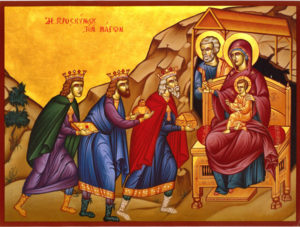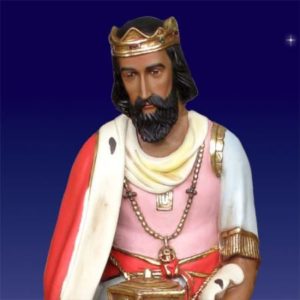Mount Calvary Church
Eutaw Street and Madison Avenue
Baltimore, Maryland
A Parish of the Roman Catholic
The Personal Ordinariate of St. Peter
Anglican Use
Rev. Albert Scharbach, Pastor
Dr. Allen Buskirk, Choirmaster
Midori Ataka, Organist
The Epiphany of Jesus Christ
Sunday, January 5, 2020
8:00 AM Said Mass
10:00 AM Sung Mass
Brunch to follow in undercroft
________________
Organ Prelude
_________________
Organ Postlude
_________________
Common
Merbecke
________________
Anthems
Reges Tharsis et Insulae, William Byrd (1540-1623)
Reges Tharsis et insulae munera offerent,
reges Arabum et Saba dona adducent.
Et adorabunt eum omnes reges terrae,
omnes gentes servient ei.
The kings of Tharsis and the isles offer their gifts,
the kings of Arabia and Sheba bring gifts.
And all the kings of the earth worship him,
all peoples bow before him.
__________
Here Is the Little Door, Herbert Howells (1892-1983)
Here is the little door,
lift up the latch, oh lift!
We need not wander more
but enter with our gift;
Our gift of finest gold,
Gold that was never bought nor sold;
Myrrh to be strewn about his bed;
Incense in clouds about his head;
All for the Child who stirs not in his sleep.
But holy slumber holds with ass and sheep.
Bend low about his bed,
for each he has a gift;
See how his eyes awake,
lift up your hands, O lift!
For gold, he gives a keen-edged sword
(Defend with it Thy little Lord!),
For incense, smoke of battle red.
Myrrh for the honored happy dead;
Gifts for his children terrible and sweet,
Touched by such tiny hands and Oh such tiny feet.
This is a 1918 setting of the following poem by Frances Chesterton (1869-1938), wife of Gilbert Keith. The date of composition, 1918, may explain the unusual imagery of the poem.
The poem depicts the visit of the Magi, first through evocative description of the traditionally attributed gifts – gold, myrrh and incense. Howells uses a modal harmony throughout, with a hushed opening in A minor leading soon after to a blazing cadence in C major for ‘Our gift of finest gold’. At ‘Incense in clouds about his head’ Howells uses his characteristic ‘Phrygian’ flattened second in the bass . Indeed there is a brief settling on the Phrygian 2nd as a chord of Eb major at ‘sleep’ before a minor plagal cadence (with added 7th!) leads us to the D major conclusion of the first verse.
The second verse is where Howells’s word-painting comes to the fore in illustrating the ambivalence of Chesterton’s text. Christ repays the Magi with his own gifts – a sword and the smoke of battle, and returns the myrrh for embalming the ‘honoured happy dead’. A far cry from the childish innocence of ‘How far is it to Bethlehem?’. Howells first flags up the new atmosphere in his use of a modal B minor cadence (as opposed to G major in the first verse) on ‘lift up your hands, O lift’, and depicts the ‘keen-edged sword’ with a unison phrase on ‘Defend with it Thy little lord’. The piece then safely returns to rest with a repetition of the sublime extended plagal cadence of the first verse.
Despite this resolution, there is an uncomfortable tension wrought by the poem and setting which cannot be ignored. How can a message of peace and love be reconciled with a call to arms? Perhaps ‘Here is the Little Door’ can serve as a salutary reminder; that there is an ever-present possibility for bold faith to be used in the service of deadly hate.
_________________
Hymns
#51 We three kings (WE THREE KINGS / KINGS OF ORIENT), words and music, was written by Pittsburgh native John Henry Hopkins, Jr. (1820-1891). He received his education at the University of Vermont and at General Theological Seminary in New York City, graduating in 1850. Hopkins then became the first church music instructor at General Theological Seminary. The imagery of the star is central to the Epiphany season and the narrative. The refrain focuses on the star and invites us to join the magi in following its light—“guide us to thy perfect light.”
“We three kings” has many features associated with Christmas carols including a refrain, a narrative-ballad style, and a lilting tune in triple meter. While the traditional number of magi is usually set at three, probably because of the three gifts that the biblical narrative discusses, it is unusual for Epiphany hymns to actually identify the number of magi as three. Stanzas two, three, and four describe in detail the symbolic nature of each of the three gifts of gold, frankincense, and myrrh.
From its inception, the composer encouraged the song’s dramatic possibilities: “Each of verses, 2, 3, and 4, is sung as a solo [Kings Gaspar, Melchior, and Balthazar] to the music of Gaspar’s part to the 1st and 5th verses, the accompaniment and chorus being the same throughout. Only verses 1 and 5 are sung as a trio. Men’s voices are best for the parts of the Three Kings, but the music is set in the G clef for the accommodation of children.”
#47 What star is this (PUER NOBIS) is a translation by John Chandler (1806–1876) of the hymn by Charles Coffin, Quae stella sole pulchrior, from the Paris Breviary (1736). The hymn is a prayer for God’s presence in our lives as we draw closer to Him. The Magi showed faith in God and eagerness, as well as sacrifice, in their journey to see the Christ-child. So may we live as though we really believe and eagerly look forward to the day when we shall one day see Him. In the third stanza, the gifts of the Magi are not even named. The Magi took the trouble to bring “gifts most rare” on a long journey. So may we “All our costliest treasures bring, Christ, to Thee, our heavenly King.” This pilgrimage is not easy, so we sing, “Holy Jesus, every day keep us in the narrow way,” remembering that Jesus said, “For the gate is narrow and the way is hard that leads to life, and those who find it are few” (Matthew 7:14).
#52 As with gladness men of old (DIX) is by William Catterton Dix (1837–1898). The particular strength of the hymn is the way in which in each of the first three verses the narrative of the visit of the wise men is related to the present day in the final couplet, opening with the word ‘So’. The themes of travel and of light are continued in the last two verses, which deal with the journey through life towards the heavenly kingdom. Our life is a pilgrimage to the day when we meet Christ face to face.
This hymn is always sung to the tune DIX. Conrad Kocher, a German composer and church musician, originally wrote a longer version of this tune in 1838 for a German chorale in 1838. William H. Monk, editor of the 1861 edition of Hymns Ancient & Modern, altered the music by omitting one phrase and changing a few notes to fit “As with Gladness” for the 1861 edition. It is interesting to note that William Chatterton Dix did not like the choice of this tune. However, it pairs well with his hymn, and it has become standard at Epiphany. Now this tune bears his name.
__________________
Balthazar
Many decades ago, while I was a graduate student at the University of Virginia., I taught a course in the Literature of Fantasy (Quest of the Holy Grail, Tolkien, C.S. Lewis etc). I asked the students to write three papers each semester. I told them, if they so chose, one could be a fantasy story.
A black student in the class wrote a story which was set as an autobiography. In the story, a young black male wrote the story of his life, its ups and downs, mostly downs, missed opportunities, and bad decisions. At least he was called before the Great Assizes, and the Book of Life was read aloud (we had just heard it being read in the story). Confronted with the facts, he had to admit to God he had badly screwed up. But the black King, Balthazar, interceded and discussed the matter with God. God agreed to give the young man a second chance and he was back on earth, in a literature course at the University of Virginia.
I told the student it was a remarkable and remarkably structured story, but I thought the ending was a bit of a trick ending. “But that’s the way it really happened!” he replied. I was so startled I declined the opportunity to pursue the remark — a failure I still regret

